Business Taxation Report: Trading Profits, Self-Employment, and VAT
VerifiedAdded on 2022/12/29
|12
|3481
|479
Report
AI Summary
This report delves into the intricacies of business taxation, commencing with an analysis of Linda's trading profits, detailing permissible and non-permissible expenses, and explaining key financial accounting terminologies such as trading accounts, income statements, and balance sheets. It then transitions to a discussion on the criteria for employment versus self-employment, highlighting the advantages of self-employment such as flexible schedules and financial incentives. The report explores the six badges of trade used by HMRC to determine economic activity, including the profit motive, volume of transactions, and character of properties. Finally, it examines different VAT schemes for VAT-registered companies, explaining the calculation methods and the role of VAT in the supply chain. The report provides an in-depth understanding of corporation tax, VAT, and other relevant aspects of business taxation.

Business
Taxation
Taxation
Paraphrase This Document
Need a fresh take? Get an instant paraphrase of this document with our AI Paraphraser
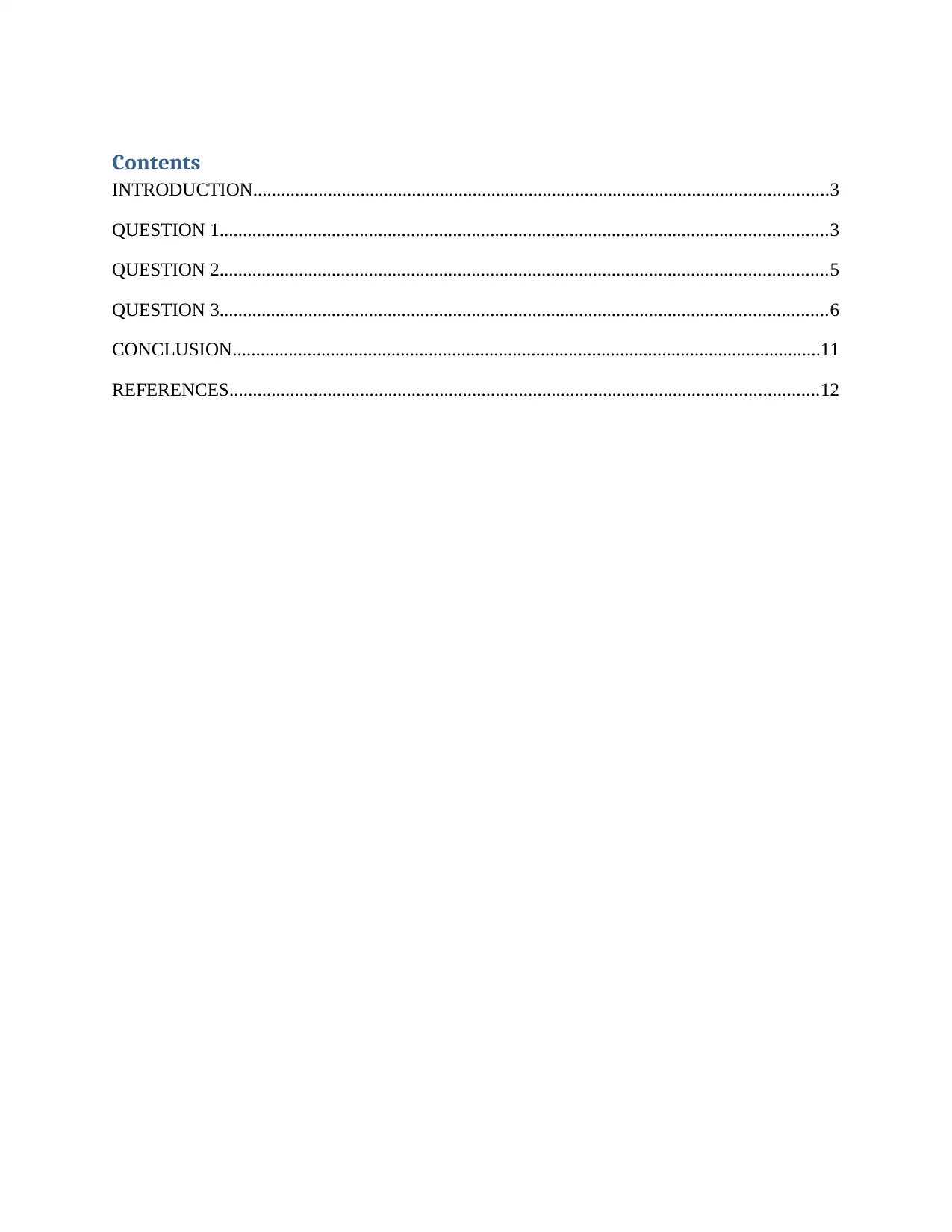
Contents
INTRODUCTION...........................................................................................................................3
QUESTION 1..................................................................................................................................3
QUESTION 2..................................................................................................................................5
QUESTION 3..................................................................................................................................6
CONCLUSION..............................................................................................................................11
REFERENCES..............................................................................................................................12
INTRODUCTION...........................................................................................................................3
QUESTION 1..................................................................................................................................3
QUESTION 2..................................................................................................................................5
QUESTION 3..................................................................................................................................6
CONCLUSION..............................................................................................................................11
REFERENCES..............................................................................................................................12
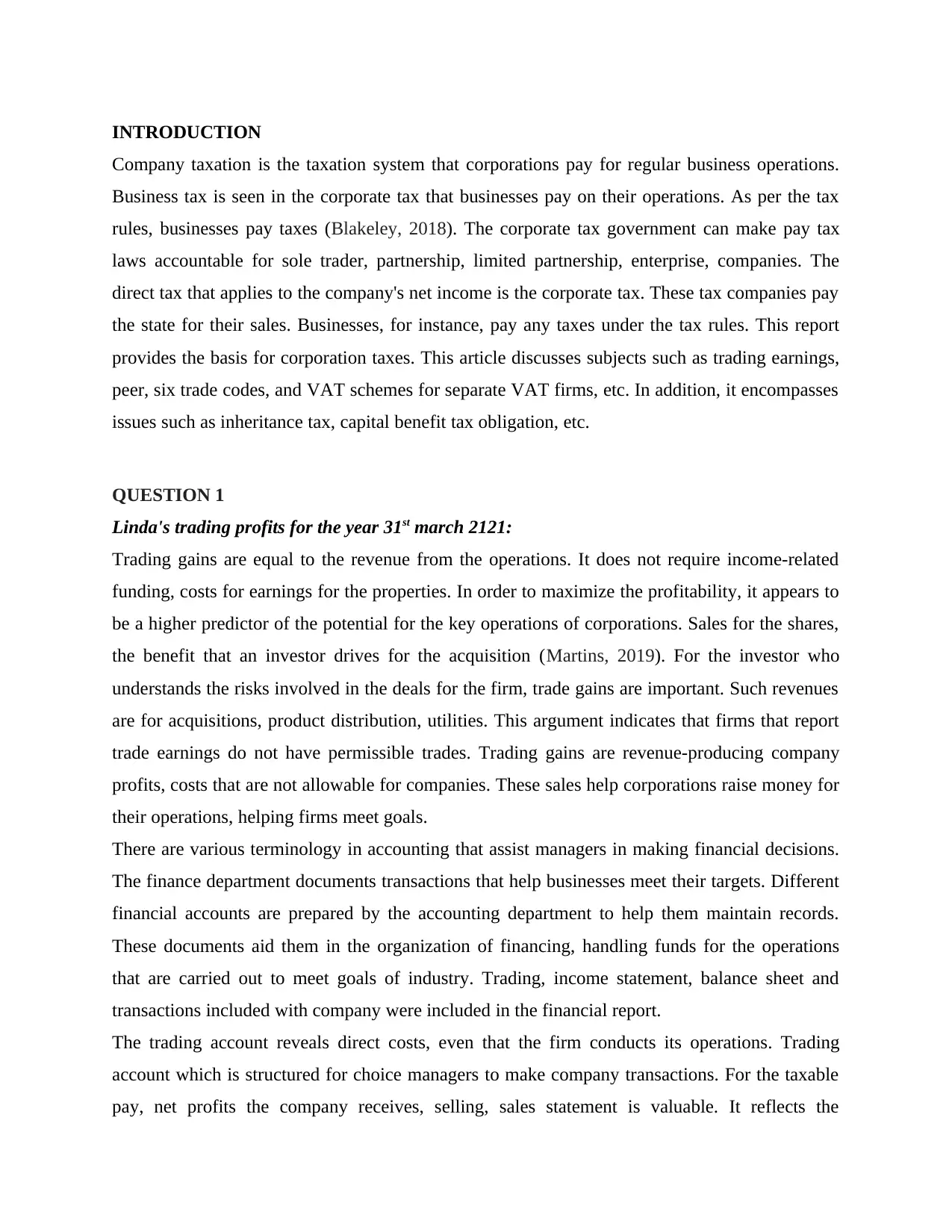
INTRODUCTION
Company taxation is the taxation system that corporations pay for regular business operations.
Business tax is seen in the corporate tax that businesses pay on their operations. As per the tax
rules, businesses pay taxes (Blakeley, 2018). The corporate tax government can make pay tax
laws accountable for sole trader, partnership, limited partnership, enterprise, companies. The
direct tax that applies to the company's net income is the corporate tax. These tax companies pay
the state for their sales. Businesses, for instance, pay any taxes under the tax rules. This report
provides the basis for corporation taxes. This article discusses subjects such as trading earnings,
peer, six trade codes, and VAT schemes for separate VAT firms, etc. In addition, it encompasses
issues such as inheritance tax, capital benefit tax obligation, etc.
QUESTION 1
Linda's trading profits for the year 31st march 2121:
Trading gains are equal to the revenue from the operations. It does not require income-related
funding, costs for earnings for the properties. In order to maximize the profitability, it appears to
be a higher predictor of the potential for the key operations of corporations. Sales for the shares,
the benefit that an investor drives for the acquisition (Martins, 2019). For the investor who
understands the risks involved in the deals for the firm, trade gains are important. Such revenues
are for acquisitions, product distribution, utilities. This argument indicates that firms that report
trade earnings do not have permissible trades. Trading gains are revenue-producing company
profits, costs that are not allowable for companies. These sales help corporations raise money for
their operations, helping firms meet goals.
There are various terminology in accounting that assist managers in making financial decisions.
The finance department documents transactions that help businesses meet their targets. Different
financial accounts are prepared by the accounting department to help them maintain records.
These documents aid them in the organization of financing, handling funds for the operations
that are carried out to meet goals of industry. Trading, income statement, balance sheet and
transactions included with company were included in the financial report.
The trading account reveals direct costs, even that the firm conducts its operations. Trading
account which is structured for choice managers to make company transactions. For the taxable
pay, net profits the company receives, selling, sales statement is valuable. It reflects the
Company taxation is the taxation system that corporations pay for regular business operations.
Business tax is seen in the corporate tax that businesses pay on their operations. As per the tax
rules, businesses pay taxes (Blakeley, 2018). The corporate tax government can make pay tax
laws accountable for sole trader, partnership, limited partnership, enterprise, companies. The
direct tax that applies to the company's net income is the corporate tax. These tax companies pay
the state for their sales. Businesses, for instance, pay any taxes under the tax rules. This report
provides the basis for corporation taxes. This article discusses subjects such as trading earnings,
peer, six trade codes, and VAT schemes for separate VAT firms, etc. In addition, it encompasses
issues such as inheritance tax, capital benefit tax obligation, etc.
QUESTION 1
Linda's trading profits for the year 31st march 2121:
Trading gains are equal to the revenue from the operations. It does not require income-related
funding, costs for earnings for the properties. In order to maximize the profitability, it appears to
be a higher predictor of the potential for the key operations of corporations. Sales for the shares,
the benefit that an investor drives for the acquisition (Martins, 2019). For the investor who
understands the risks involved in the deals for the firm, trade gains are important. Such revenues
are for acquisitions, product distribution, utilities. This argument indicates that firms that report
trade earnings do not have permissible trades. Trading gains are revenue-producing company
profits, costs that are not allowable for companies. These sales help corporations raise money for
their operations, helping firms meet goals.
There are various terminology in accounting that assist managers in making financial decisions.
The finance department documents transactions that help businesses meet their targets. Different
financial accounts are prepared by the accounting department to help them maintain records.
These documents aid them in the organization of financing, handling funds for the operations
that are carried out to meet goals of industry. Trading, income statement, balance sheet and
transactions included with company were included in the financial report.
The trading account reveals direct costs, even that the firm conducts its operations. Trading
account which is structured for choice managers to make company transactions. For the taxable
pay, net profits the company receives, selling, sales statement is valuable. It reflects the
⊘ This is a preview!⊘
Do you want full access?
Subscribe today to unlock all pages.

Trusted by 1+ million students worldwide
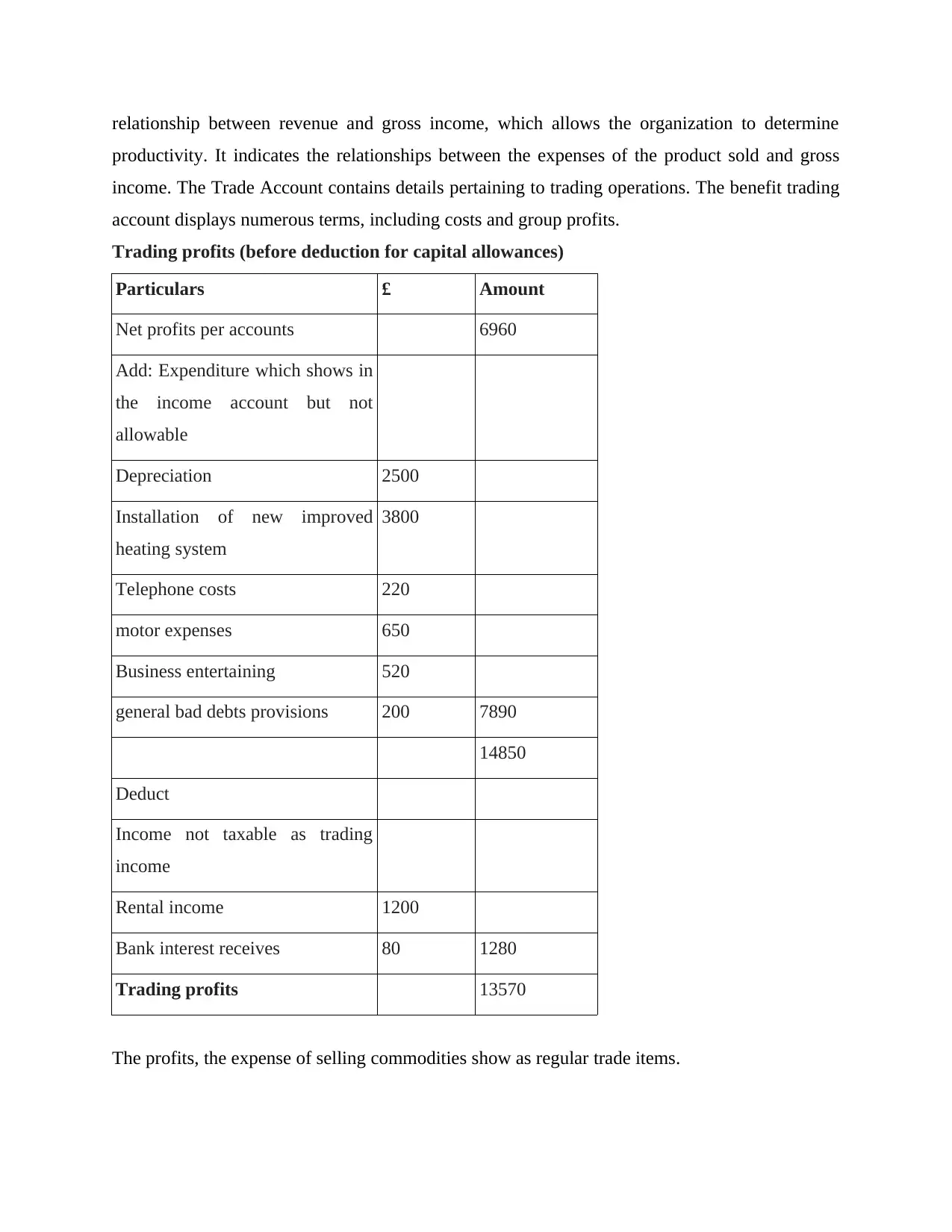
relationship between revenue and gross income, which allows the organization to determine
productivity. It indicates the relationships between the expenses of the product sold and gross
income. The Trade Account contains details pertaining to trading operations. The benefit trading
account displays numerous terms, including costs and group profits.
Trading profits (before deduction for capital allowances)
Particulars £ Amount
Net profits per accounts 6960
Add: Expenditure which shows in
the income account but not
allowable
Depreciation 2500
Installation of new improved
heating system
3800
Telephone costs 220
motor expenses 650
Business entertaining 520
general bad debts provisions 200 7890
14850
Deduct
Income not taxable as trading
income
Rental income 1200
Bank interest receives 80 1280
Trading profits 13570
The profits, the expense of selling commodities show as regular trade items.
productivity. It indicates the relationships between the expenses of the product sold and gross
income. The Trade Account contains details pertaining to trading operations. The benefit trading
account displays numerous terms, including costs and group profits.
Trading profits (before deduction for capital allowances)
Particulars £ Amount
Net profits per accounts 6960
Add: Expenditure which shows in
the income account but not
allowable
Depreciation 2500
Installation of new improved
heating system
3800
Telephone costs 220
motor expenses 650
Business entertaining 520
general bad debts provisions 200 7890
14850
Deduct
Income not taxable as trading
income
Rental income 1200
Bank interest receives 80 1280
Trading profits 13570
The profits, the expense of selling commodities show as regular trade items.
Paraphrase This Document
Need a fresh take? Get an instant paraphrase of this document with our AI Paraphraser
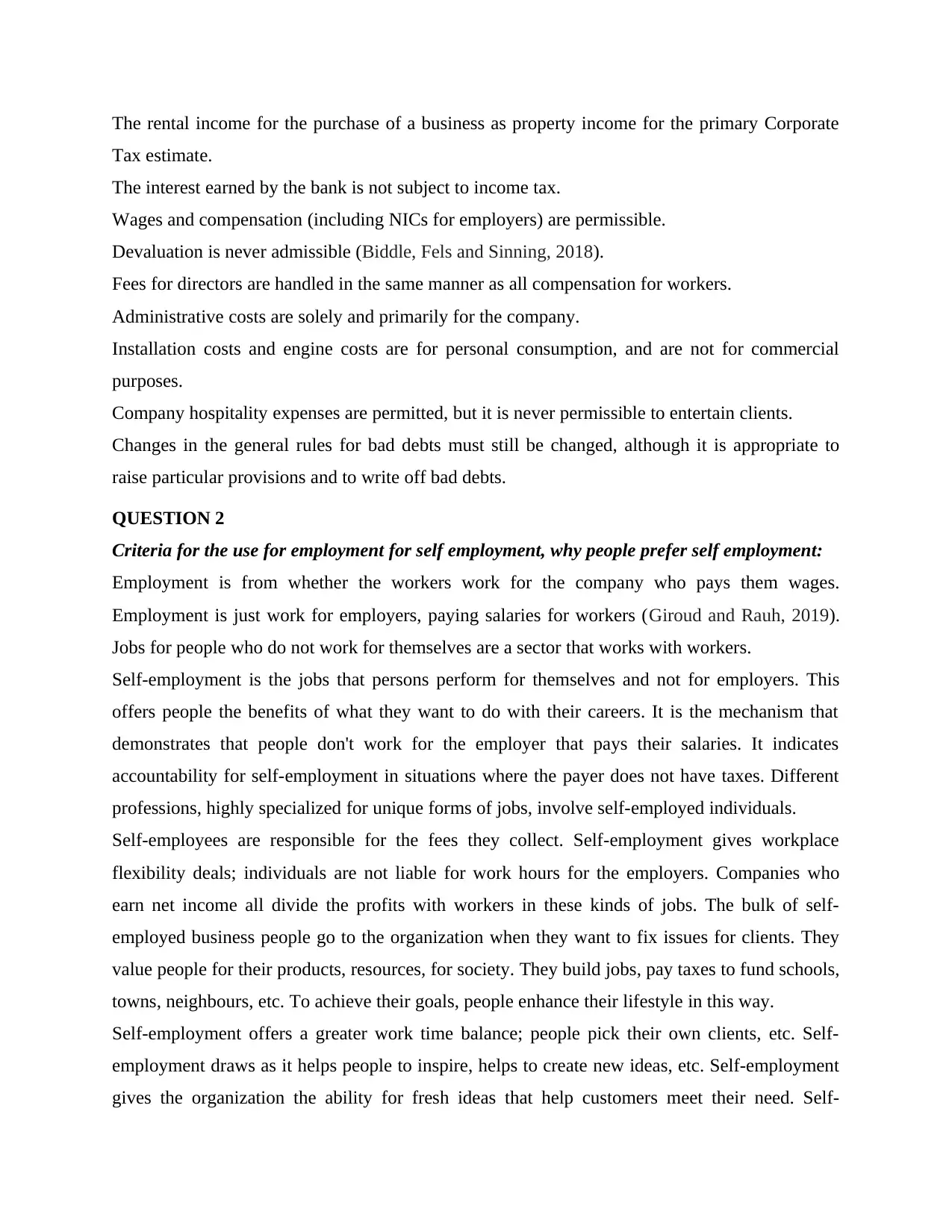
The rental income for the purchase of a business as property income for the primary Corporate
Tax estimate.
The interest earned by the bank is not subject to income tax.
Wages and compensation (including NICs for employers) are permissible.
Devaluation is never admissible (Biddle, Fels and Sinning, 2018).
Fees for directors are handled in the same manner as all compensation for workers.
Administrative costs are solely and primarily for the company.
Installation costs and engine costs are for personal consumption, and are not for commercial
purposes.
Company hospitality expenses are permitted, but it is never permissible to entertain clients.
Changes in the general rules for bad debts must still be changed, although it is appropriate to
raise particular provisions and to write off bad debts.
QUESTION 2
Criteria for the use for employment for self employment, why people prefer self employment:
Employment is from whether the workers work for the company who pays them wages.
Employment is just work for employers, paying salaries for workers (Giroud and Rauh, 2019).
Jobs for people who do not work for themselves are a sector that works with workers.
Self-employment is the jobs that persons perform for themselves and not for employers. This
offers people the benefits of what they want to do with their careers. It is the mechanism that
demonstrates that people don't work for the employer that pays their salaries. It indicates
accountability for self-employment in situations where the payer does not have taxes. Different
professions, highly specialized for unique forms of jobs, involve self-employed individuals.
Self-employees are responsible for the fees they collect. Self-employment gives workplace
flexibility deals; individuals are not liable for work hours for the employers. Companies who
earn net income all divide the profits with workers in these kinds of jobs. The bulk of self-
employed business people go to the organization when they want to fix issues for clients. They
value people for their products, resources, for society. They build jobs, pay taxes to fund schools,
towns, neighbours, etc. To achieve their goals, people enhance their lifestyle in this way.
Self-employment offers a greater work time balance; people pick their own clients, etc. Self-
employment draws as it helps people to inspire, helps to create new ideas, etc. Self-employment
gives the organization the ability for fresh ideas that help customers meet their need. Self-
Tax estimate.
The interest earned by the bank is not subject to income tax.
Wages and compensation (including NICs for employers) are permissible.
Devaluation is never admissible (Biddle, Fels and Sinning, 2018).
Fees for directors are handled in the same manner as all compensation for workers.
Administrative costs are solely and primarily for the company.
Installation costs and engine costs are for personal consumption, and are not for commercial
purposes.
Company hospitality expenses are permitted, but it is never permissible to entertain clients.
Changes in the general rules for bad debts must still be changed, although it is appropriate to
raise particular provisions and to write off bad debts.
QUESTION 2
Criteria for the use for employment for self employment, why people prefer self employment:
Employment is from whether the workers work for the company who pays them wages.
Employment is just work for employers, paying salaries for workers (Giroud and Rauh, 2019).
Jobs for people who do not work for themselves are a sector that works with workers.
Self-employment is the jobs that persons perform for themselves and not for employers. This
offers people the benefits of what they want to do with their careers. It is the mechanism that
demonstrates that people don't work for the employer that pays their salaries. It indicates
accountability for self-employment in situations where the payer does not have taxes. Different
professions, highly specialized for unique forms of jobs, involve self-employed individuals.
Self-employees are responsible for the fees they collect. Self-employment gives workplace
flexibility deals; individuals are not liable for work hours for the employers. Companies who
earn net income all divide the profits with workers in these kinds of jobs. The bulk of self-
employed business people go to the organization when they want to fix issues for clients. They
value people for their products, resources, for society. They build jobs, pay taxes to fund schools,
towns, neighbours, etc. To achieve their goals, people enhance their lifestyle in this way.
Self-employment offers a greater work time balance; people pick their own clients, etc. Self-
employment draws as it helps people to inspire, helps to create new ideas, etc. Self-employment
gives the organization the ability for fresh ideas that help customers meet their need. Self-
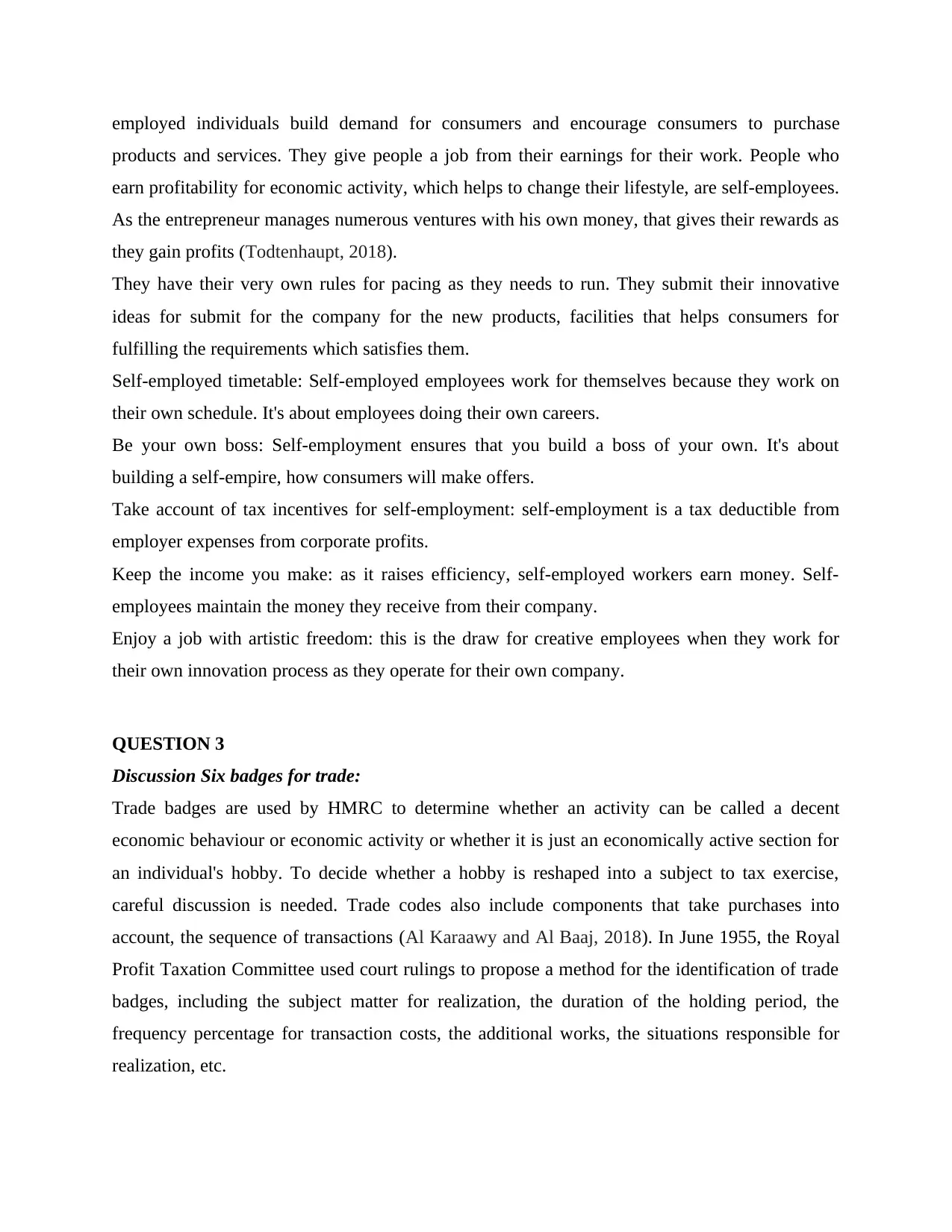
employed individuals build demand for consumers and encourage consumers to purchase
products and services. They give people a job from their earnings for their work. People who
earn profitability for economic activity, which helps to change their lifestyle, are self-employees.
As the entrepreneur manages numerous ventures with his own money, that gives their rewards as
they gain profits (Todtenhaupt, 2018).
They have their very own rules for pacing as they needs to run. They submit their innovative
ideas for submit for the company for the new products, facilities that helps consumers for
fulfilling the requirements which satisfies them.
Self-employed timetable: Self-employed employees work for themselves because they work on
their own schedule. It's about employees doing their own careers.
Be your own boss: Self-employment ensures that you build a boss of your own. It's about
building a self-empire, how consumers will make offers.
Take account of tax incentives for self-employment: self-employment is a tax deductible from
employer expenses from corporate profits.
Keep the income you make: as it raises efficiency, self-employed workers earn money. Self-
employees maintain the money they receive from their company.
Enjoy a job with artistic freedom: this is the draw for creative employees when they work for
their own innovation process as they operate for their own company.
QUESTION 3
Discussion Six badges for trade:
Trade badges are used by HMRC to determine whether an activity can be called a decent
economic behaviour or economic activity or whether it is just an economically active section for
an individual's hobby. To decide whether a hobby is reshaped into a subject to tax exercise,
careful discussion is needed. Trade codes also include components that take purchases into
account, the sequence of transactions (Al Karaawy and Al Baaj, 2018). In June 1955, the Royal
Profit Taxation Committee used court rulings to propose a method for the identification of trade
badges, including the subject matter for realization, the duration of the holding period, the
frequency percentage for transaction costs, the additional works, the situations responsible for
realization, etc.
products and services. They give people a job from their earnings for their work. People who
earn profitability for economic activity, which helps to change their lifestyle, are self-employees.
As the entrepreneur manages numerous ventures with his own money, that gives their rewards as
they gain profits (Todtenhaupt, 2018).
They have their very own rules for pacing as they needs to run. They submit their innovative
ideas for submit for the company for the new products, facilities that helps consumers for
fulfilling the requirements which satisfies them.
Self-employed timetable: Self-employed employees work for themselves because they work on
their own schedule. It's about employees doing their own careers.
Be your own boss: Self-employment ensures that you build a boss of your own. It's about
building a self-empire, how consumers will make offers.
Take account of tax incentives for self-employment: self-employment is a tax deductible from
employer expenses from corporate profits.
Keep the income you make: as it raises efficiency, self-employed workers earn money. Self-
employees maintain the money they receive from their company.
Enjoy a job with artistic freedom: this is the draw for creative employees when they work for
their own innovation process as they operate for their own company.
QUESTION 3
Discussion Six badges for trade:
Trade badges are used by HMRC to determine whether an activity can be called a decent
economic behaviour or economic activity or whether it is just an economically active section for
an individual's hobby. To decide whether a hobby is reshaped into a subject to tax exercise,
careful discussion is needed. Trade codes also include components that take purchases into
account, the sequence of transactions (Al Karaawy and Al Baaj, 2018). In June 1955, the Royal
Profit Taxation Committee used court rulings to propose a method for the identification of trade
badges, including the subject matter for realization, the duration of the holding period, the
frequency percentage for transaction costs, the additional works, the situations responsible for
realization, etc.
⊘ This is a preview!⊘
Do you want full access?
Subscribe today to unlock all pages.

Trusted by 1+ million students worldwide
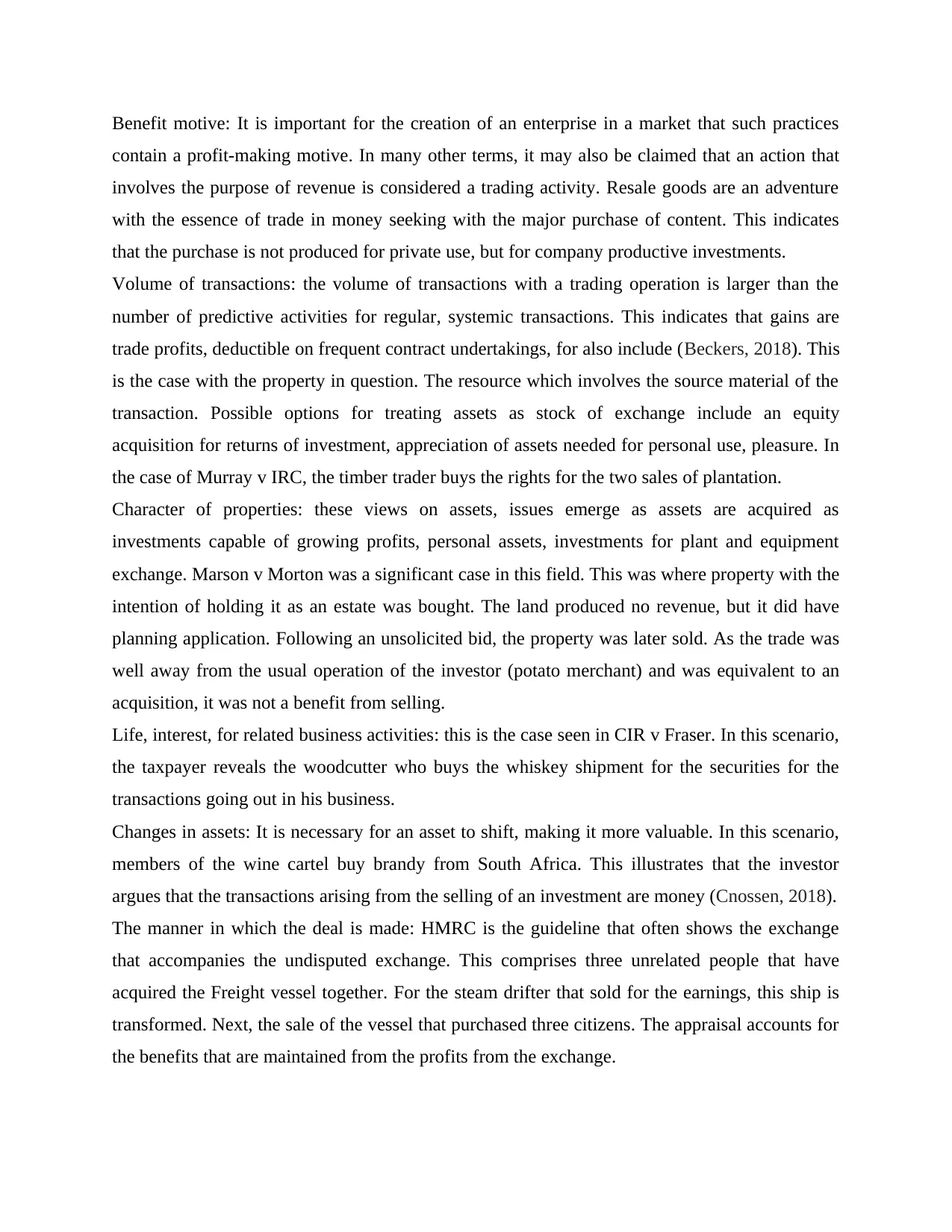
Benefit motive: It is important for the creation of an enterprise in a market that such practices
contain a profit-making motive. In many other terms, it may also be claimed that an action that
involves the purpose of revenue is considered a trading activity. Resale goods are an adventure
with the essence of trade in money seeking with the major purchase of content. This indicates
that the purchase is not produced for private use, but for company productive investments.
Volume of transactions: the volume of transactions with a trading operation is larger than the
number of predictive activities for regular, systemic transactions. This indicates that gains are
trade profits, deductible on frequent contract undertakings, for also include (Beckers, 2018). This
is the case with the property in question. The resource which involves the source material of the
transaction. Possible options for treating assets as stock of exchange include an equity
acquisition for returns of investment, appreciation of assets needed for personal use, pleasure. In
the case of Murray v IRC, the timber trader buys the rights for the two sales of plantation.
Character of properties: these views on assets, issues emerge as assets are acquired as
investments capable of growing profits, personal assets, investments for plant and equipment
exchange. Marson v Morton was a significant case in this field. This was where property with the
intention of holding it as an estate was bought. The land produced no revenue, but it did have
planning application. Following an unsolicited bid, the property was later sold. As the trade was
well away from the usual operation of the investor (potato merchant) and was equivalent to an
acquisition, it was not a benefit from selling.
Life, interest, for related business activities: this is the case seen in CIR v Fraser. In this scenario,
the taxpayer reveals the woodcutter who buys the whiskey shipment for the securities for the
transactions going out in his business.
Changes in assets: It is necessary for an asset to shift, making it more valuable. In this scenario,
members of the wine cartel buy brandy from South Africa. This illustrates that the investor
argues that the transactions arising from the selling of an investment are money (Cnossen, 2018).
The manner in which the deal is made: HMRC is the guideline that often shows the exchange
that accompanies the undisputed exchange. This comprises three unrelated people that have
acquired the Freight vessel together. For the steam drifter that sold for the earnings, this ship is
transformed. Next, the sale of the vessel that purchased three citizens. The appraisal accounts for
the benefits that are maintained from the profits from the exchange.
contain a profit-making motive. In many other terms, it may also be claimed that an action that
involves the purpose of revenue is considered a trading activity. Resale goods are an adventure
with the essence of trade in money seeking with the major purchase of content. This indicates
that the purchase is not produced for private use, but for company productive investments.
Volume of transactions: the volume of transactions with a trading operation is larger than the
number of predictive activities for regular, systemic transactions. This indicates that gains are
trade profits, deductible on frequent contract undertakings, for also include (Beckers, 2018). This
is the case with the property in question. The resource which involves the source material of the
transaction. Possible options for treating assets as stock of exchange include an equity
acquisition for returns of investment, appreciation of assets needed for personal use, pleasure. In
the case of Murray v IRC, the timber trader buys the rights for the two sales of plantation.
Character of properties: these views on assets, issues emerge as assets are acquired as
investments capable of growing profits, personal assets, investments for plant and equipment
exchange. Marson v Morton was a significant case in this field. This was where property with the
intention of holding it as an estate was bought. The land produced no revenue, but it did have
planning application. Following an unsolicited bid, the property was later sold. As the trade was
well away from the usual operation of the investor (potato merchant) and was equivalent to an
acquisition, it was not a benefit from selling.
Life, interest, for related business activities: this is the case seen in CIR v Fraser. In this scenario,
the taxpayer reveals the woodcutter who buys the whiskey shipment for the securities for the
transactions going out in his business.
Changes in assets: It is necessary for an asset to shift, making it more valuable. In this scenario,
members of the wine cartel buy brandy from South Africa. This illustrates that the investor
argues that the transactions arising from the selling of an investment are money (Cnossen, 2018).
The manner in which the deal is made: HMRC is the guideline that often shows the exchange
that accompanies the undisputed exchange. This comprises three unrelated people that have
acquired the Freight vessel together. For the steam drifter that sold for the earnings, this ship is
transformed. Next, the sale of the vessel that purchased three citizens. The appraisal accounts for
the benefits that are maintained from the profits from the exchange.
Paraphrase This Document
Need a fresh take? Get an instant paraphrase of this document with our AI Paraphraser

Source of finance: Where the trade held for the undertakings, the source of finance is significant.
Fund takes the acquisition of an asset and indicates the redemption of asset debts.
Purchase interval periods, sales: The length of the assets retained is an accurate determinant for
trading. The longer the span of possession, the greater the expenditure.
Different VAT schemes for the various VAT registered companies:
Value added tax is the position of consumption tax on goods where the value added by each
supply chain system, from manufacturing to sales for consumers, is applied. The amount of VAT
charged by consumers for the cost of the goods is the cost of material use for goods previously
taxed (Agarwal and Chakraborty, 2019). VAT is the mechanism for which the value-added tax
for the products supply chain, the services produced by the organization, is used in order to meet
its goals. Economic value tax helps pay for the shared network that supplies the states, taxpayers
that use the products, facilities for the supply of the same locality. Not all localities need VAT
charges, but exports are excluded. VAT is the levy on locations, where the corporate taxes are
the basis for the position of the buyers who have registered for the purchase price of the goods
and services. The terms VAT, GST, tax on sales are used by each other. A sixth increase in VAT
on gross tax receipts. There are VAT calculation methods that include the method of credit bill,
balance bases. Sales purchases are taxed in the credit-invoice process, with the buyer advised of
the VAT on the sale, and companies may earn VAT compensation paid on input products,
services. With the exception of Japan, it is the highest employee base system that is used by
national VATs. The design of accounts base, which involves a company, measures the amount of
all taxable transactions by subtracting the amount of all taxable expenditures in respect to which
the VAT rates are added at the benefit of the variance. This approach is only used for Japan, but
it still includes the Flat Tax terms, which are the tax elements for US legislators to make
proposals (Bushnyakova and Kashirina, 2019). The accounting principles have different
accounting techniques. Accrual accounting compares earnings with the time in that they are
received and matches costs with the period during that they are paid. Although it is more difficult
than paying for the cash base, it provides effective information. The Generic VAT Budgetary
Requirements is a form of recording VAT where VAT is reported and charged on the grounds of
when receipts are given. Underneath the VAT Standard Accounting Scheme, companies accept a
VAT Return four times per year.
Fund takes the acquisition of an asset and indicates the redemption of asset debts.
Purchase interval periods, sales: The length of the assets retained is an accurate determinant for
trading. The longer the span of possession, the greater the expenditure.
Different VAT schemes for the various VAT registered companies:
Value added tax is the position of consumption tax on goods where the value added by each
supply chain system, from manufacturing to sales for consumers, is applied. The amount of VAT
charged by consumers for the cost of the goods is the cost of material use for goods previously
taxed (Agarwal and Chakraborty, 2019). VAT is the mechanism for which the value-added tax
for the products supply chain, the services produced by the organization, is used in order to meet
its goals. Economic value tax helps pay for the shared network that supplies the states, taxpayers
that use the products, facilities for the supply of the same locality. Not all localities need VAT
charges, but exports are excluded. VAT is the levy on locations, where the corporate taxes are
the basis for the position of the buyers who have registered for the purchase price of the goods
and services. The terms VAT, GST, tax on sales are used by each other. A sixth increase in VAT
on gross tax receipts. There are VAT calculation methods that include the method of credit bill,
balance bases. Sales purchases are taxed in the credit-invoice process, with the buyer advised of
the VAT on the sale, and companies may earn VAT compensation paid on input products,
services. With the exception of Japan, it is the highest employee base system that is used by
national VATs. The design of accounts base, which involves a company, measures the amount of
all taxable transactions by subtracting the amount of all taxable expenditures in respect to which
the VAT rates are added at the benefit of the variance. This approach is only used for Japan, but
it still includes the Flat Tax terms, which are the tax elements for US legislators to make
proposals (Bushnyakova and Kashirina, 2019). The accounting principles have different
accounting techniques. Accrual accounting compares earnings with the time in that they are
received and matches costs with the period during that they are paid. Although it is more difficult
than paying for the cash base, it provides effective information. The Generic VAT Budgetary
Requirements is a form of recording VAT where VAT is reported and charged on the grounds of
when receipts are given. Underneath the VAT Standard Accounting Scheme, companies accept a
VAT Return four times per year.
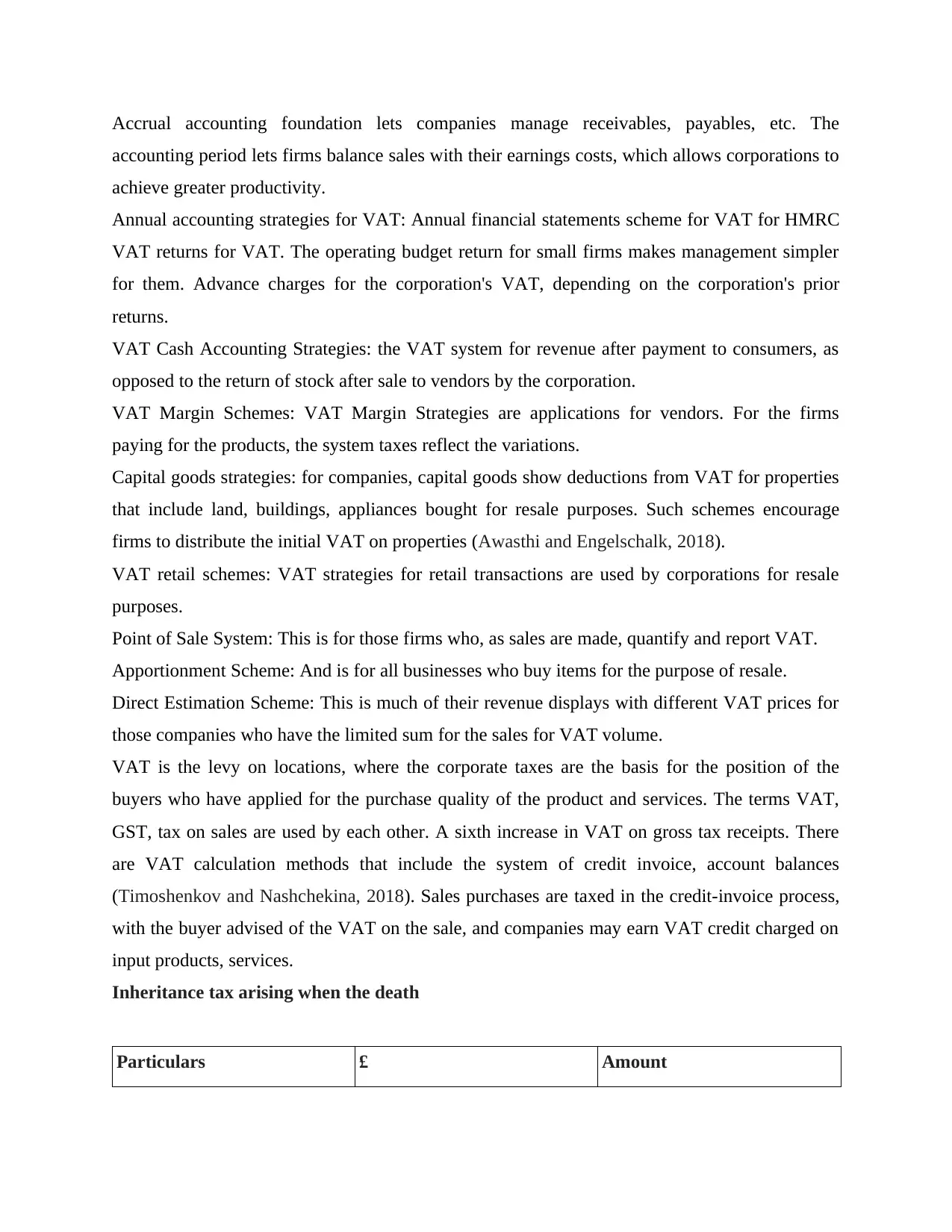
Accrual accounting foundation lets companies manage receivables, payables, etc. The
accounting period lets firms balance sales with their earnings costs, which allows corporations to
achieve greater productivity.
Annual accounting strategies for VAT: Annual financial statements scheme for VAT for HMRC
VAT returns for VAT. The operating budget return for small firms makes management simpler
for them. Advance charges for the corporation's VAT, depending on the corporation's prior
returns.
VAT Cash Accounting Strategies: the VAT system for revenue after payment to consumers, as
opposed to the return of stock after sale to vendors by the corporation.
VAT Margin Schemes: VAT Margin Strategies are applications for vendors. For the firms
paying for the products, the system taxes reflect the variations.
Capital goods strategies: for companies, capital goods show deductions from VAT for properties
that include land, buildings, appliances bought for resale purposes. Such schemes encourage
firms to distribute the initial VAT on properties (Awasthi and Engelschalk, 2018).
VAT retail schemes: VAT strategies for retail transactions are used by corporations for resale
purposes.
Point of Sale System: This is for those firms who, as sales are made, quantify and report VAT.
Apportionment Scheme: And is for all businesses who buy items for the purpose of resale.
Direct Estimation Scheme: This is much of their revenue displays with different VAT prices for
those companies who have the limited sum for the sales for VAT volume.
VAT is the levy on locations, where the corporate taxes are the basis for the position of the
buyers who have applied for the purchase quality of the product and services. The terms VAT,
GST, tax on sales are used by each other. A sixth increase in VAT on gross tax receipts. There
are VAT calculation methods that include the system of credit invoice, account balances
(Timoshenkov and Nashchekina, 2018). Sales purchases are taxed in the credit-invoice process,
with the buyer advised of the VAT on the sale, and companies may earn VAT credit charged on
input products, services.
Inheritance tax arising when the death
Particulars £ Amount
accounting period lets firms balance sales with their earnings costs, which allows corporations to
achieve greater productivity.
Annual accounting strategies for VAT: Annual financial statements scheme for VAT for HMRC
VAT returns for VAT. The operating budget return for small firms makes management simpler
for them. Advance charges for the corporation's VAT, depending on the corporation's prior
returns.
VAT Cash Accounting Strategies: the VAT system for revenue after payment to consumers, as
opposed to the return of stock after sale to vendors by the corporation.
VAT Margin Schemes: VAT Margin Strategies are applications for vendors. For the firms
paying for the products, the system taxes reflect the variations.
Capital goods strategies: for companies, capital goods show deductions from VAT for properties
that include land, buildings, appliances bought for resale purposes. Such schemes encourage
firms to distribute the initial VAT on properties (Awasthi and Engelschalk, 2018).
VAT retail schemes: VAT strategies for retail transactions are used by corporations for resale
purposes.
Point of Sale System: This is for those firms who, as sales are made, quantify and report VAT.
Apportionment Scheme: And is for all businesses who buy items for the purpose of resale.
Direct Estimation Scheme: This is much of their revenue displays with different VAT prices for
those companies who have the limited sum for the sales for VAT volume.
VAT is the levy on locations, where the corporate taxes are the basis for the position of the
buyers who have applied for the purchase quality of the product and services. The terms VAT,
GST, tax on sales are used by each other. A sixth increase in VAT on gross tax receipts. There
are VAT calculation methods that include the system of credit invoice, account balances
(Timoshenkov and Nashchekina, 2018). Sales purchases are taxed in the credit-invoice process,
with the buyer advised of the VAT on the sale, and companies may earn VAT credit charged on
input products, services.
Inheritance tax arising when the death
Particulars £ Amount
⊘ This is a preview!⊘
Do you want full access?
Subscribe today to unlock all pages.

Trusted by 1+ million students worldwide
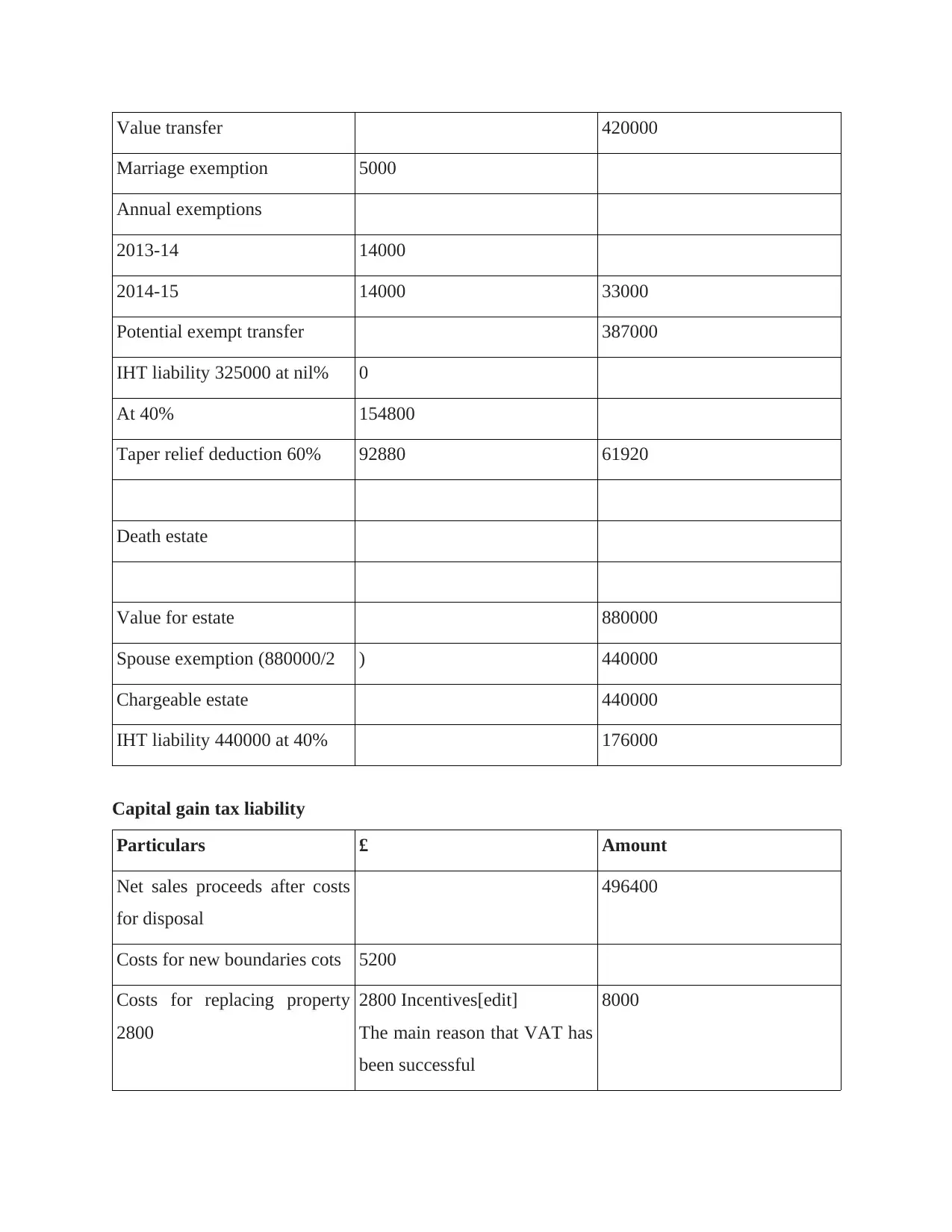
Value transfer 420000
Marriage exemption 5000
Annual exemptions
2013-14 14000
2014-15 14000 33000
Potential exempt transfer 387000
IHT liability 325000 at nil% 0
At 40% 154800
Taper relief deduction 60% 92880 61920
Death estate
Value for estate 880000
Spouse exemption (880000/2 ) 440000
Chargeable estate 440000
IHT liability 440000 at 40% 176000
Capital gain tax liability
Particulars £ Amount
Net sales proceeds after costs
for disposal
496400
Costs for new boundaries cots 5200
Costs for replacing property
2800
2800 Incentives[edit]
The main reason that VAT has
been successful
8000
Marriage exemption 5000
Annual exemptions
2013-14 14000
2014-15 14000 33000
Potential exempt transfer 387000
IHT liability 325000 at nil% 0
At 40% 154800
Taper relief deduction 60% 92880 61920
Death estate
Value for estate 880000
Spouse exemption (880000/2 ) 440000
Chargeable estate 440000
IHT liability 440000 at 40% 176000
Capital gain tax liability
Particulars £ Amount
Net sales proceeds after costs
for disposal
496400
Costs for new boundaries cots 5200
Costs for replacing property
2800
2800 Incentives[edit]
The main reason that VAT has
been successful
8000
Paraphrase This Document
Need a fresh take? Get an instant paraphrase of this document with our AI Paraphraser
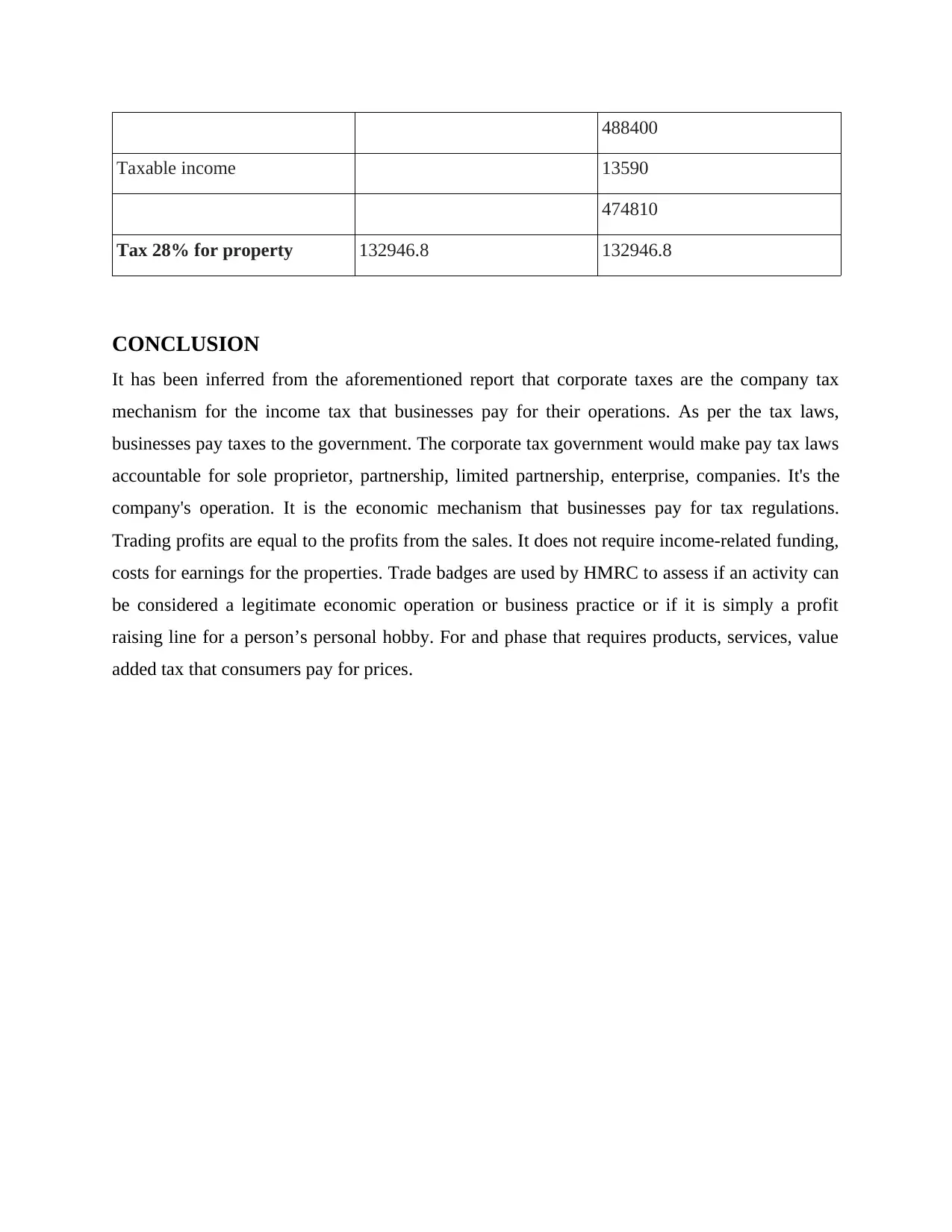
488400
Taxable income 13590
474810
Tax 28% for property 132946.8 132946.8
CONCLUSION
It has been inferred from the aforementioned report that corporate taxes are the company tax
mechanism for the income tax that businesses pay for their operations. As per the tax laws,
businesses pay taxes to the government. The corporate tax government would make pay tax laws
accountable for sole proprietor, partnership, limited partnership, enterprise, companies. It's the
company's operation. It is the economic mechanism that businesses pay for tax regulations.
Trading profits are equal to the profits from the sales. It does not require income-related funding,
costs for earnings for the properties. Trade badges are used by HMRC to assess if an activity can
be considered a legitimate economic operation or business practice or if it is simply a profit
raising line for a person’s personal hobby. For and phase that requires products, services, value
added tax that consumers pay for prices.
Taxable income 13590
474810
Tax 28% for property 132946.8 132946.8
CONCLUSION
It has been inferred from the aforementioned report that corporate taxes are the company tax
mechanism for the income tax that businesses pay for their operations. As per the tax laws,
businesses pay taxes to the government. The corporate tax government would make pay tax laws
accountable for sole proprietor, partnership, limited partnership, enterprise, companies. It's the
company's operation. It is the economic mechanism that businesses pay for tax regulations.
Trading profits are equal to the profits from the sales. It does not require income-related funding,
costs for earnings for the properties. Trade badges are used by HMRC to assess if an activity can
be considered a legitimate economic operation or business practice or if it is simply a profit
raising line for a person’s personal hobby. For and phase that requires products, services, value
added tax that consumers pay for prices.
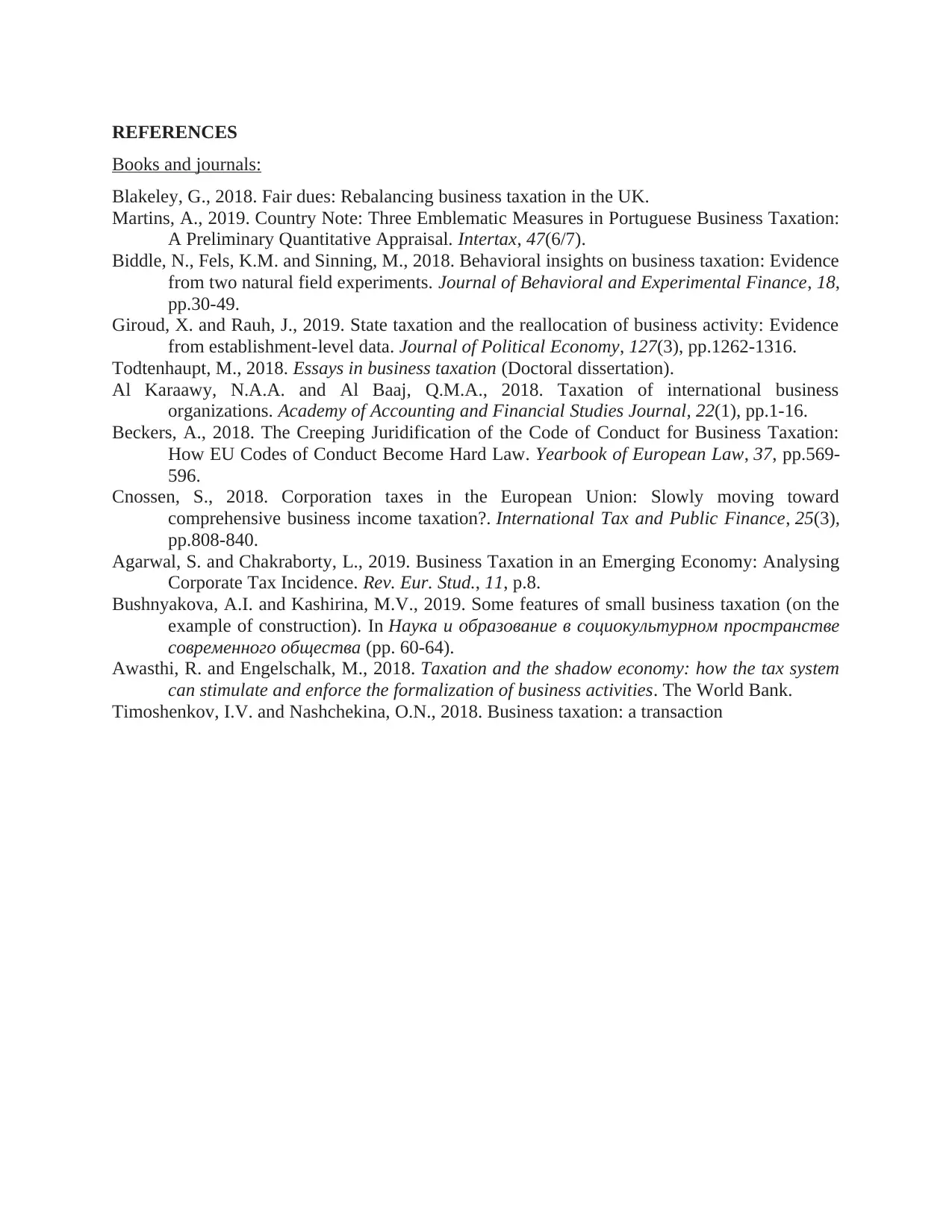
REFERENCES
Books and journals:
Blakeley, G., 2018. Fair dues: Rebalancing business taxation in the UK.
Martins, A., 2019. Country Note: Three Emblematic Measures in Portuguese Business Taxation:
A Preliminary Quantitative Appraisal. Intertax, 47(6/7).
Biddle, N., Fels, K.M. and Sinning, M., 2018. Behavioral insights on business taxation: Evidence
from two natural field experiments. Journal of Behavioral and Experimental Finance, 18,
pp.30-49.
Giroud, X. and Rauh, J., 2019. State taxation and the reallocation of business activity: Evidence
from establishment-level data. Journal of Political Economy, 127(3), pp.1262-1316.
Todtenhaupt, M., 2018. Essays in business taxation (Doctoral dissertation).
Al Karaawy, N.A.A. and Al Baaj, Q.M.A., 2018. Taxation of international business
organizations. Academy of Accounting and Financial Studies Journal, 22(1), pp.1-16.
Beckers, A., 2018. The Creeping Juridification of the Code of Conduct for Business Taxation:
How EU Codes of Conduct Become Hard Law. Yearbook of European Law, 37, pp.569-
596.
Cnossen, S., 2018. Corporation taxes in the European Union: Slowly moving toward
comprehensive business income taxation?. International Tax and Public Finance, 25(3),
pp.808-840.
Agarwal, S. and Chakraborty, L., 2019. Business Taxation in an Emerging Economy: Analysing
Corporate Tax Incidence. Rev. Eur. Stud., 11, p.8.
Bushnyakova, A.I. and Kashirina, M.V., 2019. Some features of small business taxation (on the
example of construction). In Наука и образование в социокультурном пространстве
современного общества (pp. 60-64).
Awasthi, R. and Engelschalk, M., 2018. Taxation and the shadow economy: how the tax system
can stimulate and enforce the formalization of business activities. The World Bank.
Timoshenkov, I.V. and Nashchekina, O.N., 2018. Business taxation: a transaction
Books and journals:
Blakeley, G., 2018. Fair dues: Rebalancing business taxation in the UK.
Martins, A., 2019. Country Note: Three Emblematic Measures in Portuguese Business Taxation:
A Preliminary Quantitative Appraisal. Intertax, 47(6/7).
Biddle, N., Fels, K.M. and Sinning, M., 2018. Behavioral insights on business taxation: Evidence
from two natural field experiments. Journal of Behavioral and Experimental Finance, 18,
pp.30-49.
Giroud, X. and Rauh, J., 2019. State taxation and the reallocation of business activity: Evidence
from establishment-level data. Journal of Political Economy, 127(3), pp.1262-1316.
Todtenhaupt, M., 2018. Essays in business taxation (Doctoral dissertation).
Al Karaawy, N.A.A. and Al Baaj, Q.M.A., 2018. Taxation of international business
organizations. Academy of Accounting and Financial Studies Journal, 22(1), pp.1-16.
Beckers, A., 2018. The Creeping Juridification of the Code of Conduct for Business Taxation:
How EU Codes of Conduct Become Hard Law. Yearbook of European Law, 37, pp.569-
596.
Cnossen, S., 2018. Corporation taxes in the European Union: Slowly moving toward
comprehensive business income taxation?. International Tax and Public Finance, 25(3),
pp.808-840.
Agarwal, S. and Chakraborty, L., 2019. Business Taxation in an Emerging Economy: Analysing
Corporate Tax Incidence. Rev. Eur. Stud., 11, p.8.
Bushnyakova, A.I. and Kashirina, M.V., 2019. Some features of small business taxation (on the
example of construction). In Наука и образование в социокультурном пространстве
современного общества (pp. 60-64).
Awasthi, R. and Engelschalk, M., 2018. Taxation and the shadow economy: how the tax system
can stimulate and enforce the formalization of business activities. The World Bank.
Timoshenkov, I.V. and Nashchekina, O.N., 2018. Business taxation: a transaction
⊘ This is a preview!⊘
Do you want full access?
Subscribe today to unlock all pages.

Trusted by 1+ million students worldwide
1 out of 12
Related Documents
Your All-in-One AI-Powered Toolkit for Academic Success.
+13062052269
info@desklib.com
Available 24*7 on WhatsApp / Email
![[object Object]](/_next/static/media/star-bottom.7253800d.svg)
Unlock your academic potential
Copyright © 2020–2025 A2Z Services. All Rights Reserved. Developed and managed by ZUCOL.





